The responsibility for the birth of modern roses rests on the shoulders of a Frenchman by the name of Jean-Baptiste André Guillot.
The responsibility for the birth of modern roses rests on the shoulders of a Frenchman by the name of Jean-Baptiste André Guillot – generally referred to now as Guillot Fils to differentiate between him and his father (Guillot Pere).
The family had been hybridising roses for many decades near Lyon but it took one particular cross in 1867 between a Tea rose ('Madame Bravy') and a Hybrid Perpetual ('Madame Victor Verdier') to produce a bloom that instantly astounded rose lovers.
Guillot Fils named it ‘La France’ and it was the first of what was to become known as ‘Hybrid Tea’ roses.
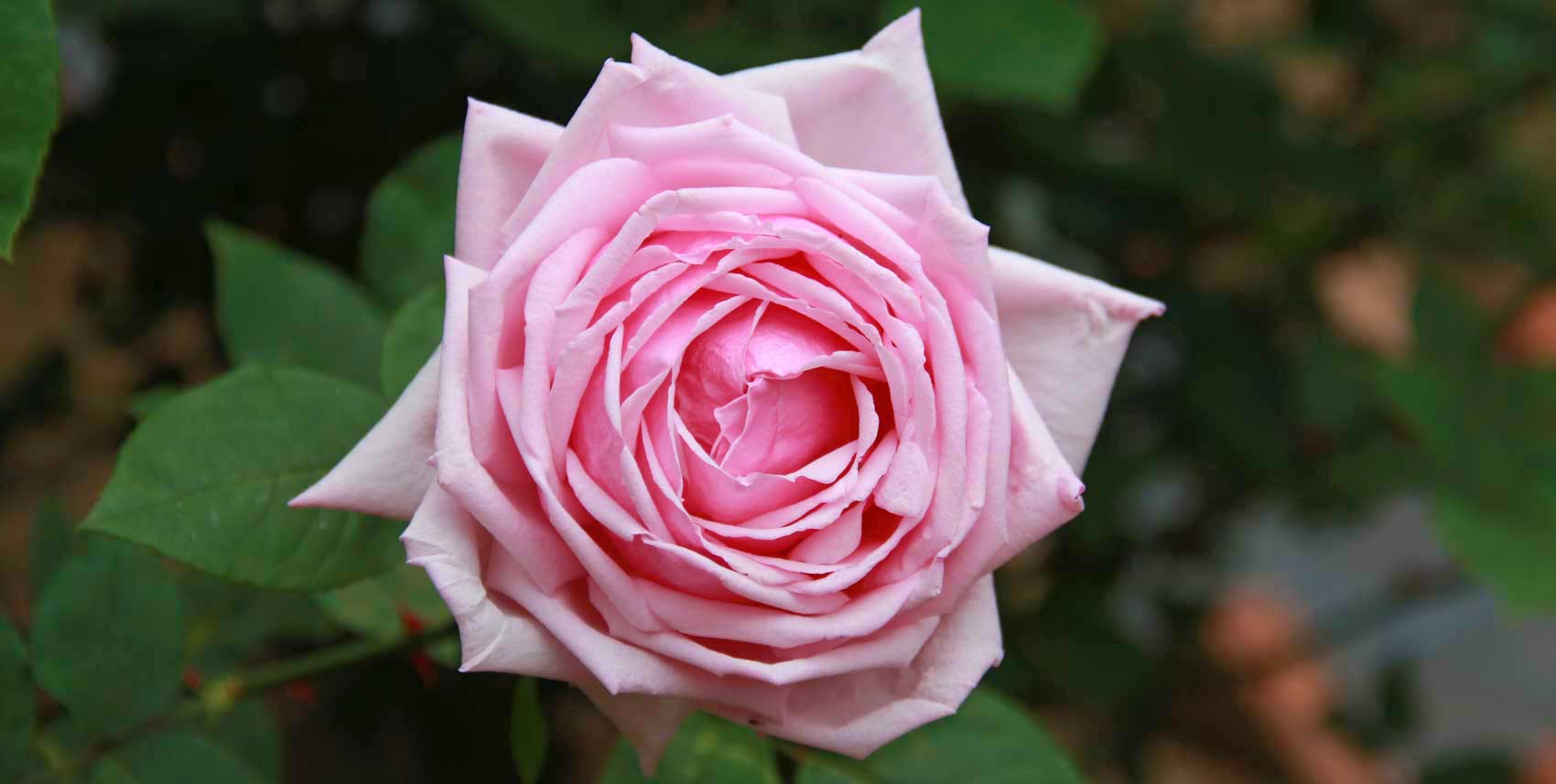 Hybrid Tea Rose ‘La France’ - photo Arashiyama
Hybrid Tea Rose ‘La France’ - photo ArashiyamaAs a result, rose breeders around Europe have been motivated ever since to create their own ‘sensation’ and the following 150 years have seen many new rose types appear.
Now generally referred to as Modern Roses they represent commercially driven breeding that has proven to be less easy to formally categorise as they all scramble for their share of a burgeoning market.
We will start with the flagship – the rose form that started the goldrush.
Hybrid Tea Roses: were hardier and more floriferous, producing blooms more often than their predecessors, with new flushes sometimes coming through every six weeks.
But it was the gently unfurling, high centred buds that that captured the market’s imagination, along with single, large blooms atop tall, straight stems and strong but delicate fragrances. Florists instantly loved them.
Hybrid Teas tended to be more compact, upright and more sparsely leafed, while losing some frost hardiness and resistance to disease of Species and Old Garden Roses. Not all are single bloomed however, with many newer varieties having groups of three or four blooms per stem.
Others joined the burgeoning new group including ‘Soleil d’Or’ in 1900 from Pernet-Ducher in Lyons.
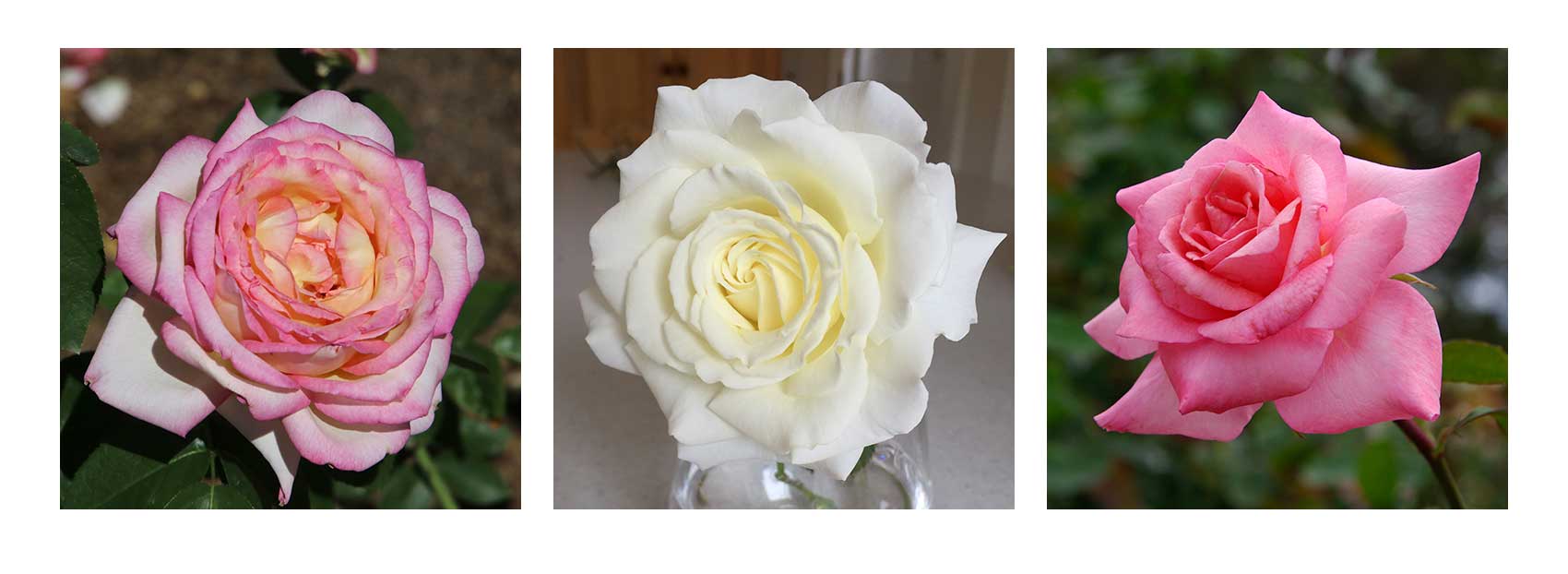 Hybrid Tea Roses - (L) Peace (C) Pope John Paul 2nd (R) Sylvia
Hybrid Tea Roses - (L) Peace (C) Pope John Paul 2nd (R) SylviaSome of the early hybrid tea roses of the 20th Century included ‘Crimson Glory’ in 1935, ‘Charlotte Armstrong’ in 1941 and perhaps the most famous rose of all the ‘Peace Rose’ bred by Francis Meilland of France in 1946 featuring pale yellow blooms suffused with gold and edged with pink.
If there is one rose that provided rocket fuel to this already popular class, it was ‘Peace’.
In the 50's ‘Garden Party’, ‘Tiffany’ and ‘Chrysler Imperial’ were released, while the 60's saw the release of the truly wonderful ‘Mister Lincoln’ with its intense fragrance and richly velvet red flowers. If ever there was a bloom to swoon over, it is this one.
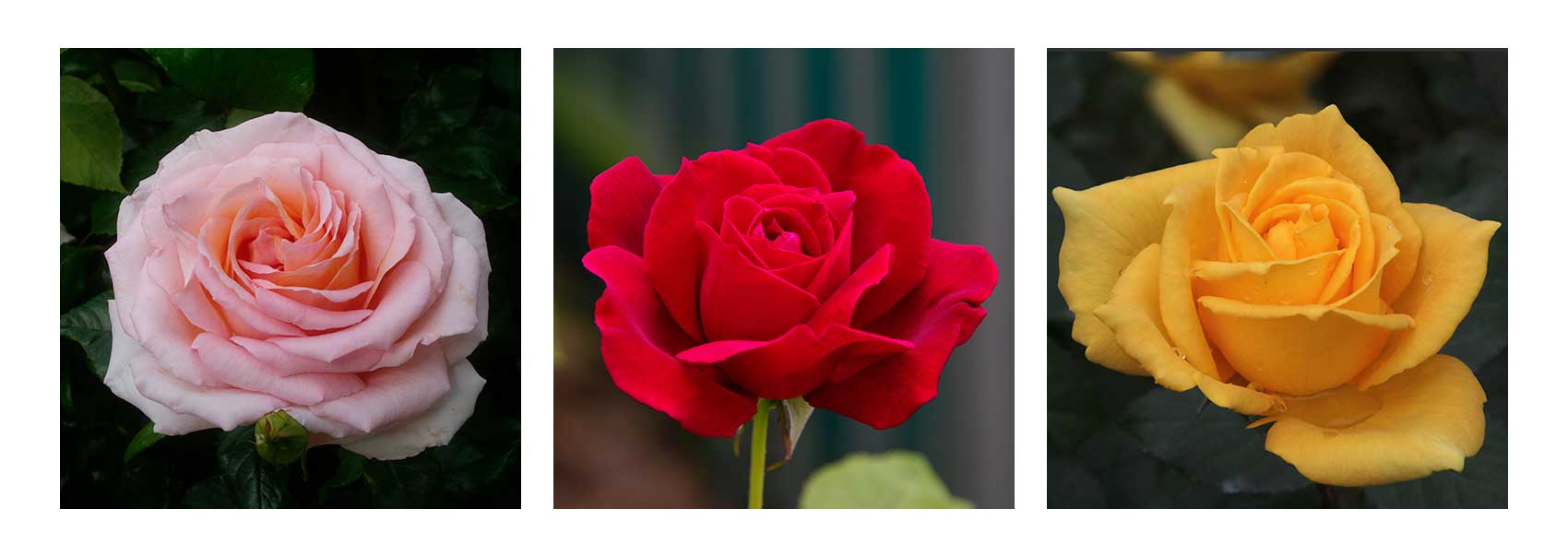 Hybrid Tea Roses - (L) Chandos Beauty (C) Mr Lincoln (R) Inka
Hybrid Tea Roses - (L) Chandos Beauty (C) Mr Lincoln (R) InkaTens of thousands of uniquely different hybrid tea rose varieties have been introduced since 1867. Some of the early creations are still available today but most have disappeared as new and improved varieties are introduced each year.
Most hybrid tea roses now are grafted onto rootstock, like Rosa multiflora, which help them to get established faster and more vigorously.
Hybrid Teas are generally easy to grow and quite hardy, most liking a month or two of cold weather to encourage new buds to form.
The world loves the ravishingly beautiful Hybrid Teas, with hundreds of millions sold around the world every year, they dominate flower shows and capture the hearts and lenses of millions of photographers with their unabashed elegance.
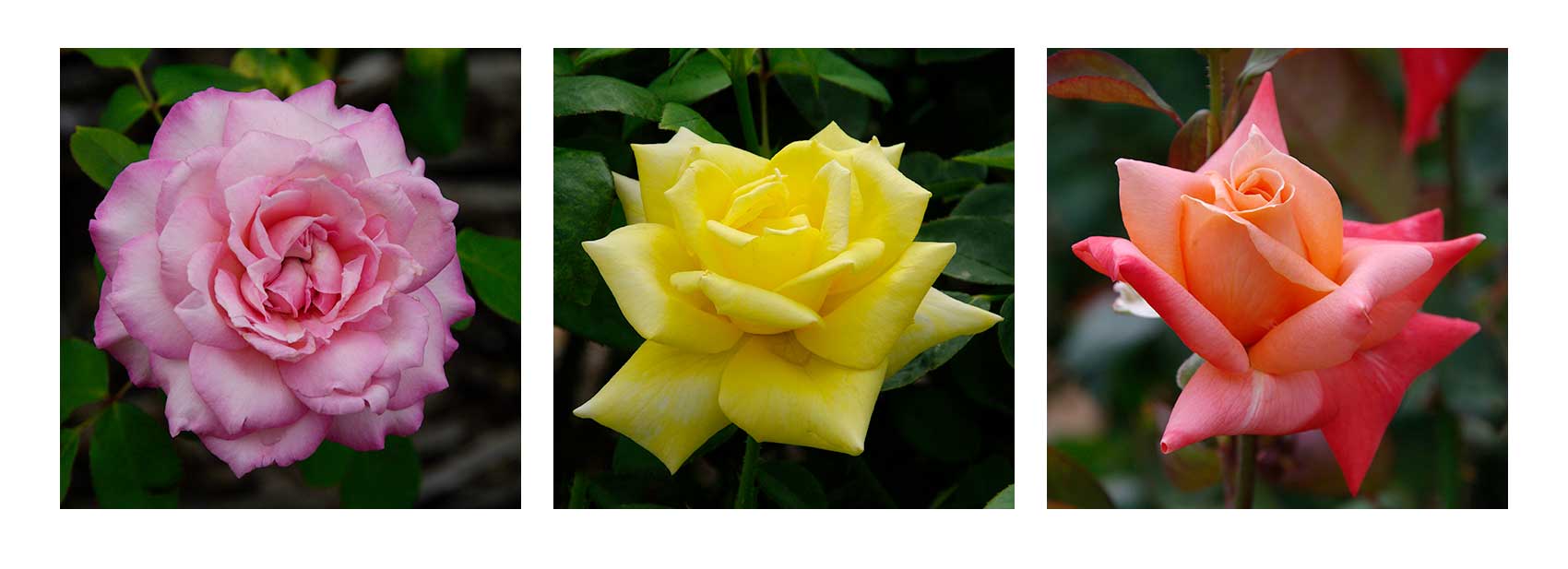 Hybrid Tea Roses - (L) Madame President (C) Helmut Schmidt (R) Lovers Meeting
Hybrid Tea Roses - (L) Madame President (C) Helmut Schmidt (R) Lovers MeetingHere are the other main Modern Garden Rose Groups:-
Climbers: Most species roses were natural scramblers e.g. they would produce long arching stems that continued to flower year on year as there was no-one to prune them back.
Modern climbers however are generally variations or mutations of shrub roses that will feature the flower forms of the original while producing long lived, branching stems that can be trained on supports such as arbors, trellises, fences, and walls.
These are the decorative roses that typify the English cottage Garden style so beloved around the world as they drape elegantly over archways, garden gates and doorways to thatched cottages.
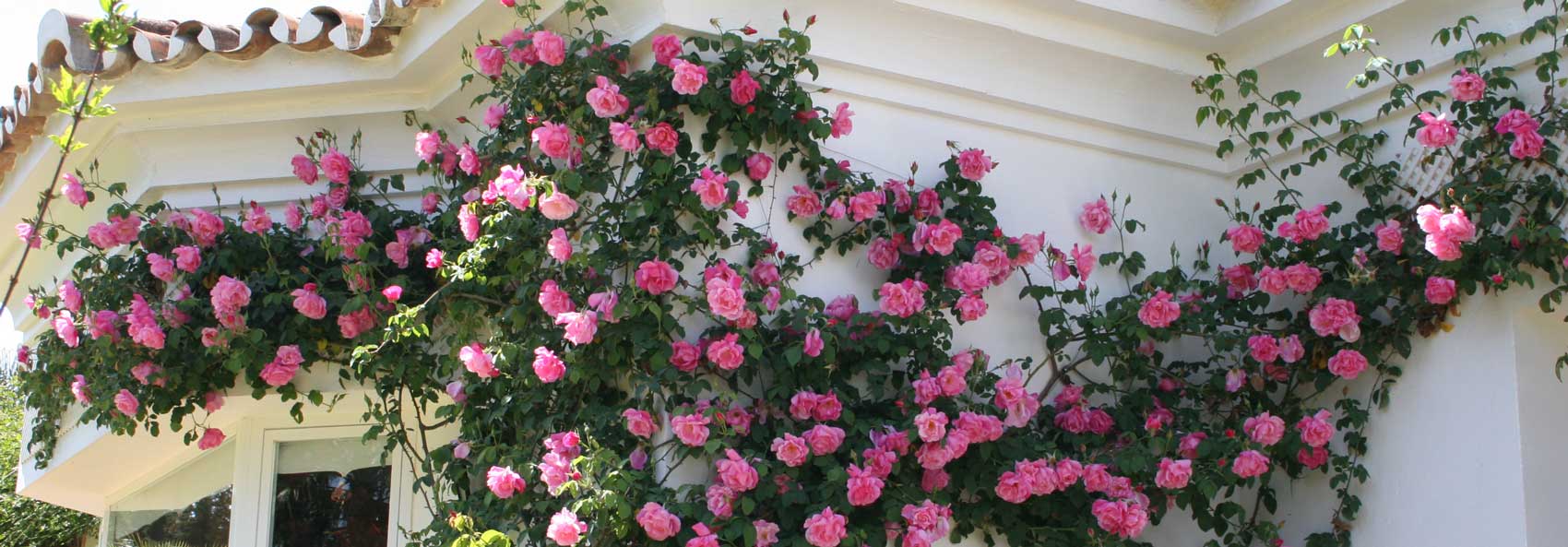 Climbing Rose
Climbing RoseClimbing Roses combine perfectly with Clematis for this intense ‘romantic’ look. Climbers in general require plenty of love and attention and always grow best in good, well drained soils that are fertilised regularly. You’ll also need to dead-head them regularly in order to maximise blooming.
Popular varieties include ‘Lamarque’ – lemony-white, ‘Cecile Brunner’ – pale pink with shades of toffee, ‘Gold Bunny’ – ruffled double yellow, ‘Pierre de Ronsard’ – beautifully pale pink, ‘Karlsruhe’ – rich red and ‘James Galaway’ – salmon pink and richly ruffled.
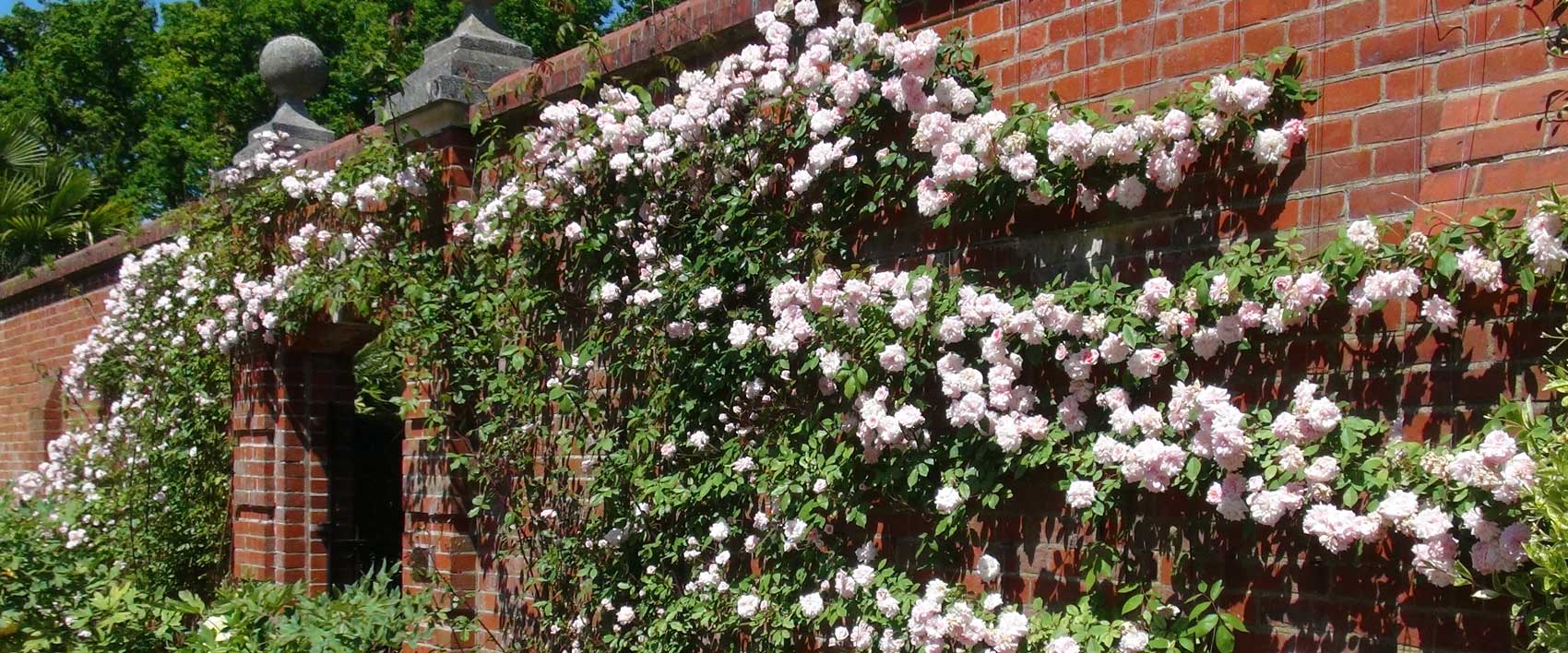 Climbing Rose - Cecile Brunner
Climbing Rose - Cecile BrunnerRamblers: on the other hand are more vigorous, sending up shoots from ground level that will find their way up into trees and shrubs closeby to take advantage of the elevation for sunshine.
Flowers tend to appear once a stem is into its second year, but perform best if pruned back hard and often.
These are plants that need space, lots of space and are perfect to cover large unsightly objects like out-houses or garden walls. Flowers tend to be smaller but produced in abundance in large sprays, generally only twice per season. It is quite common for rambling roses to be completely covered in blooms in peak flowering time.
These are plants to set and forget – they will grow in almost any soil, sun or partial shade and need no maintenance or feeding and be resistant to pests and diseases, though they can look a bit unkempt after a few years in between flowering.
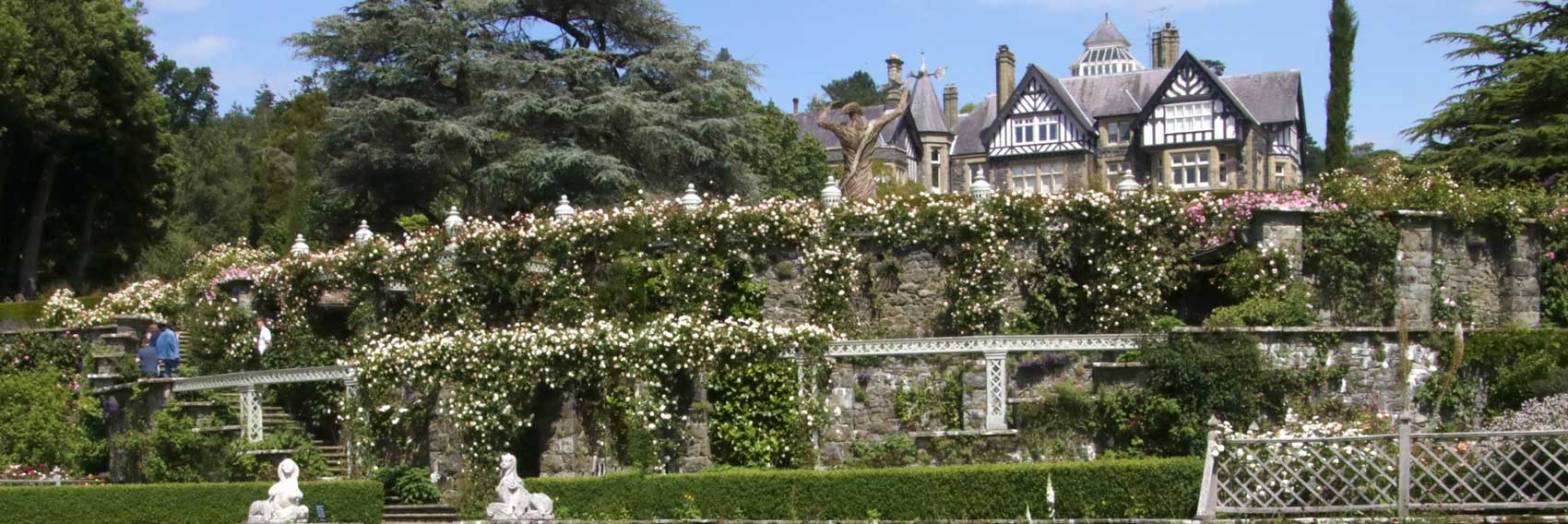 Rambling Roses at Bodnant Gardens, North Wales
Rambling Roses at Bodnant Gardens, North WalesWell known cultivars include: ‘Alberic Barbier’, ‘Albertine’ and ‘Rambling Rector’, ‘Ghislaine de Felingonde, Rosa banksiae lutea (Lady Banks Rose). Unlike many ‘Malvern Hills’ will flower repeatedly throughout the season.
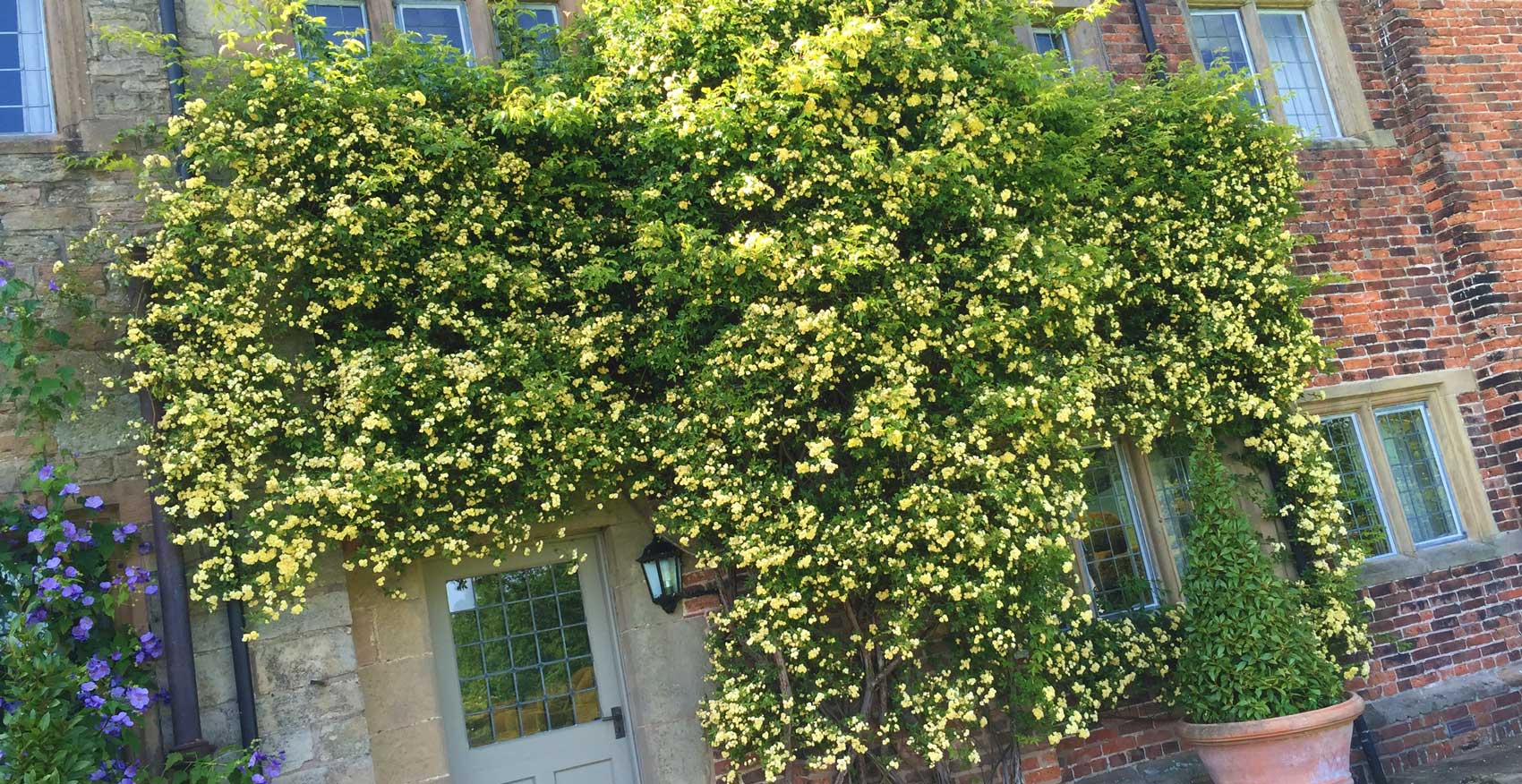 Rosa banksiae Lutea - a species rambling rose
Rosa banksiae Lutea - a species rambling roseGroundcover or Landscape Roses: In the late 20th century, hybrid tea and floribunda roses started losing popularity due to their susceptibility to pests and diseases. So a group of breeders led by Meilland of France and Noak of Germany, along with Radlers of the USA set about creating lower maintenance plants.
The result was the new form of ‘Groundcover Roses’ that produced plenty of fragrance and colour through repeat flowering, while needing little pruning and spraying to keep them at their best.
They are generally no more than 60cms tall, feature smaller flowers though are very free-flowering and generally are bred on their own rootstock therefore do not need to be grafted.
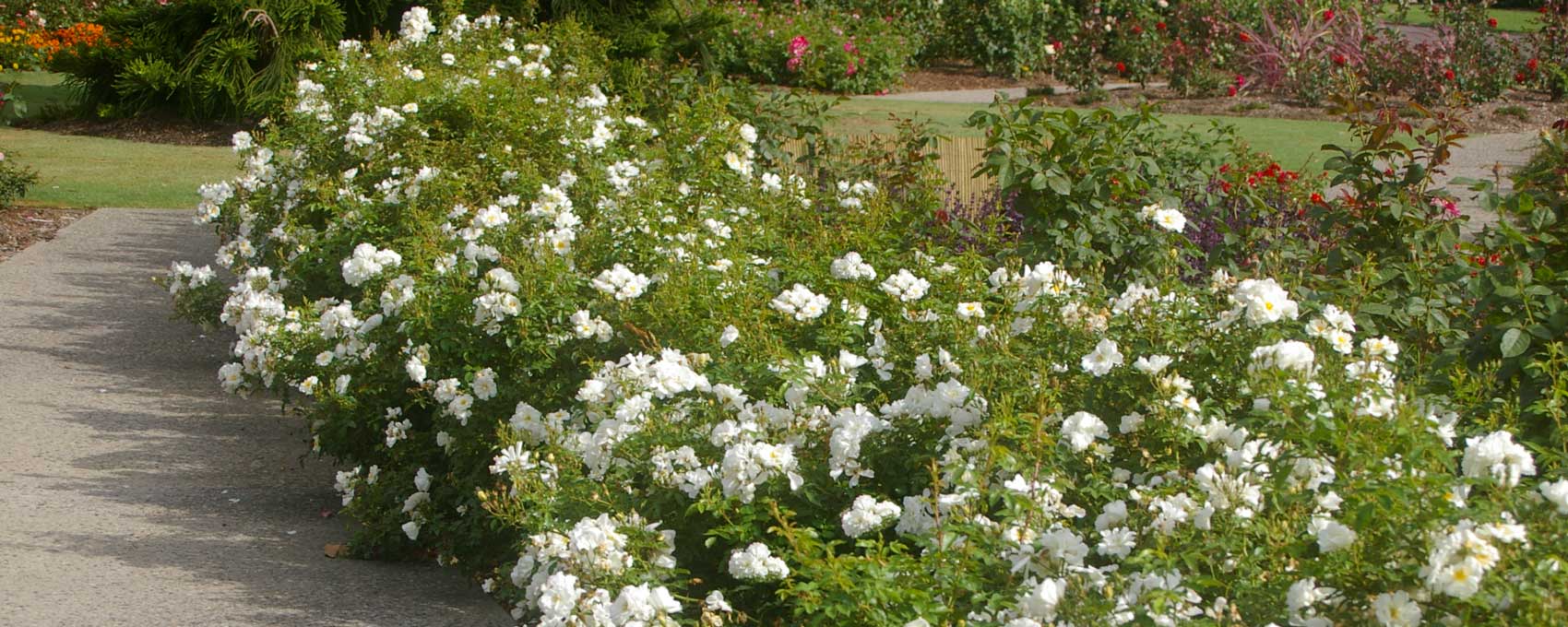 Groundcover Rose - "Diamant'
Groundcover Rose - "Diamant'Popular varieties include:- ‘Diamant’ – pure white, ‘Mainau Feuer’ – brilliant scarlet, ‘Seafoam’ looks like its name.
Flower Carpet is a very popular group of groundcover roses, claiming to be the world’s number one seller. Some plants will produce up to 2,000 flowers from spring through to autumn.
Floribunda Roses: These are increasingly popular with gardeners to the point that they run a close second to Hybrid Teas. Floribunda roses are shrub roses that produce large clusters of flowers with continuous blooms but they are not particularly fragrant. They are a cross between Polyantha and Hybrid Teas, with the growth habit being bushy and full and generally hardier.
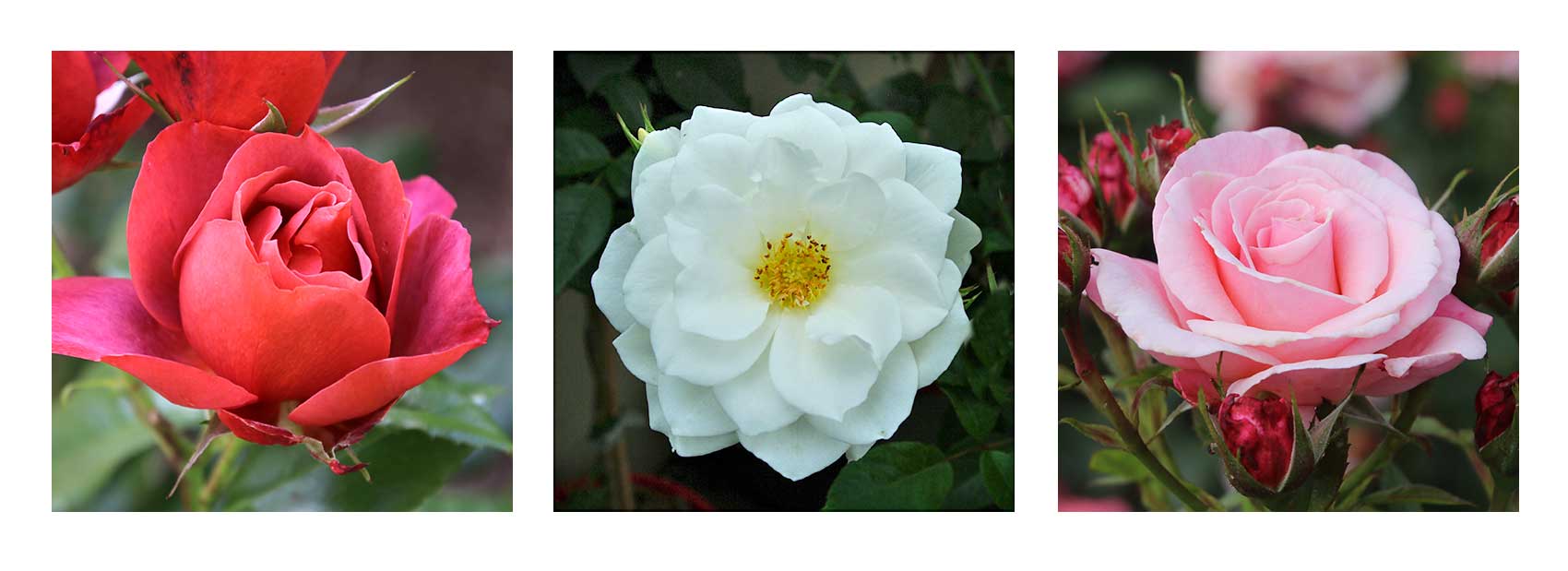 Floribunda Roses - (L) ‘Hot Chocolate’ (C) ‘Iceberg’ (R) ‘Tickled Pink’
Floribunda Roses - (L) ‘Hot Chocolate’ (C) ‘Iceberg’ (R) ‘Tickled Pink’Floribundas vary in height, can make good lower hedges, work well when planted en-masse or in swathes, they also go well in pots. Floribundas also require little spring pruning, just some dead-heading or removal of dead wood.
One of the most well known Floribunda Roses is the white ‘Iceberg’ bred by Kordes, others include ‘Bonica 82’ from Meilland, ‘Amber Queen’ from Harkness, ‘Dainty Maid’ from LeGrice, ‘English Miss’ by Cant, ‘Julia Child’ from Carruth, ‘Sexy Rexy’ from McGredy,
Grandiflora Roses: being Latin for “large-flowered”. These were first created in mid 20th century as back crosses of hybrid teas and floribundas. The results were tall and vigorous rose plants that produced larger flowers singly or in clusters of three to five blooms.
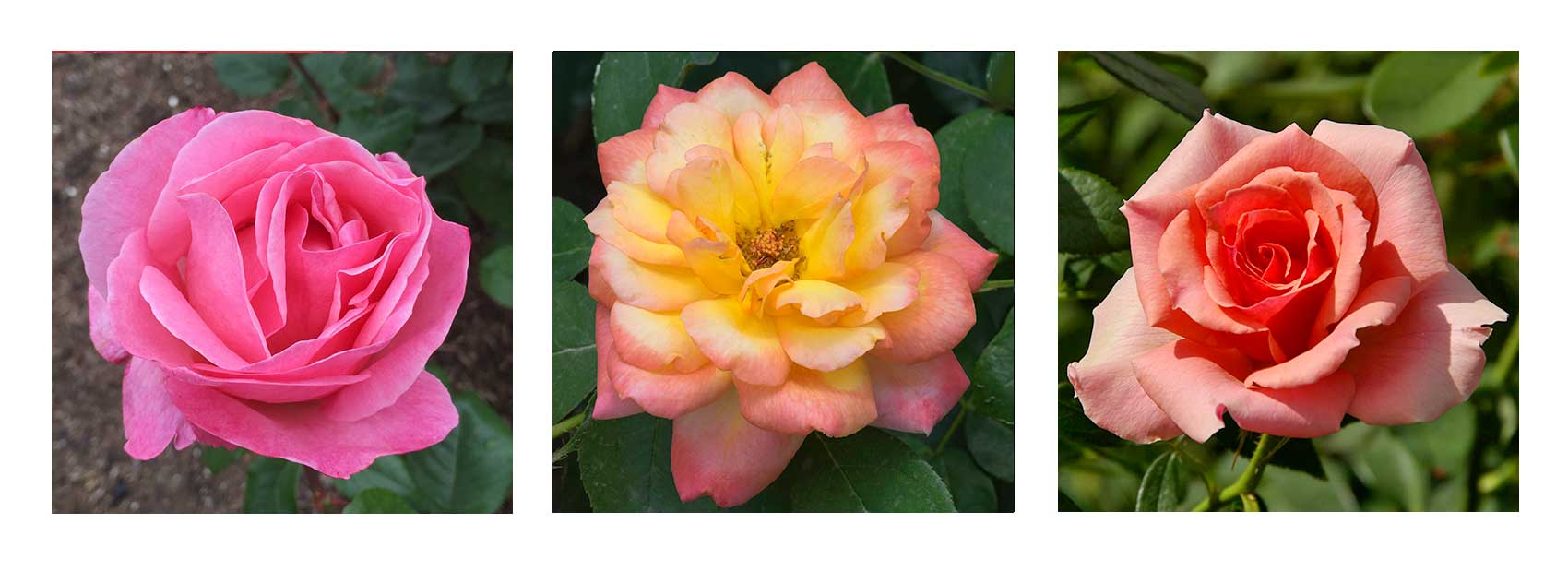 Grandiflora Roses - (L) Queen Elizabeth (C) Glowing Peace (R) Tournament of Roses
Grandiflora Roses - (L) Queen Elizabeth (C) Glowing Peace (R) Tournament of RosesGrandifloras are considered to be the tallest of all roses except climbers and ramblers and as such work well at the back of mixed borders. They also make very good cut flowers and are very hardy and vigorous by nature.
They were very popular on introduction in the 1950’s but that popularity waned towards the late 80’s.
Examples include: 'Comanche,' 'Montezuma', ‘Lagerfeld’ and 'Queen Elizabeth'.
Polyantha Roses: the name comes from the Greek "poly" ("many") and "anthos" ("flower").
Polyantha Roses first appeared in France in the late 19th century around the same time as Hybrid Teas and were originally bred from crosses between Rosa chinensis and Rosa multiflora.
The first and highly celebrated was ‘Parquerette’ in 1873 with large clusters of white flowers.
Many more have been bred since, all featuring smaller flowers (2.5cms) on compact, free-flowering rose bushes in shades of white, pink, and red.
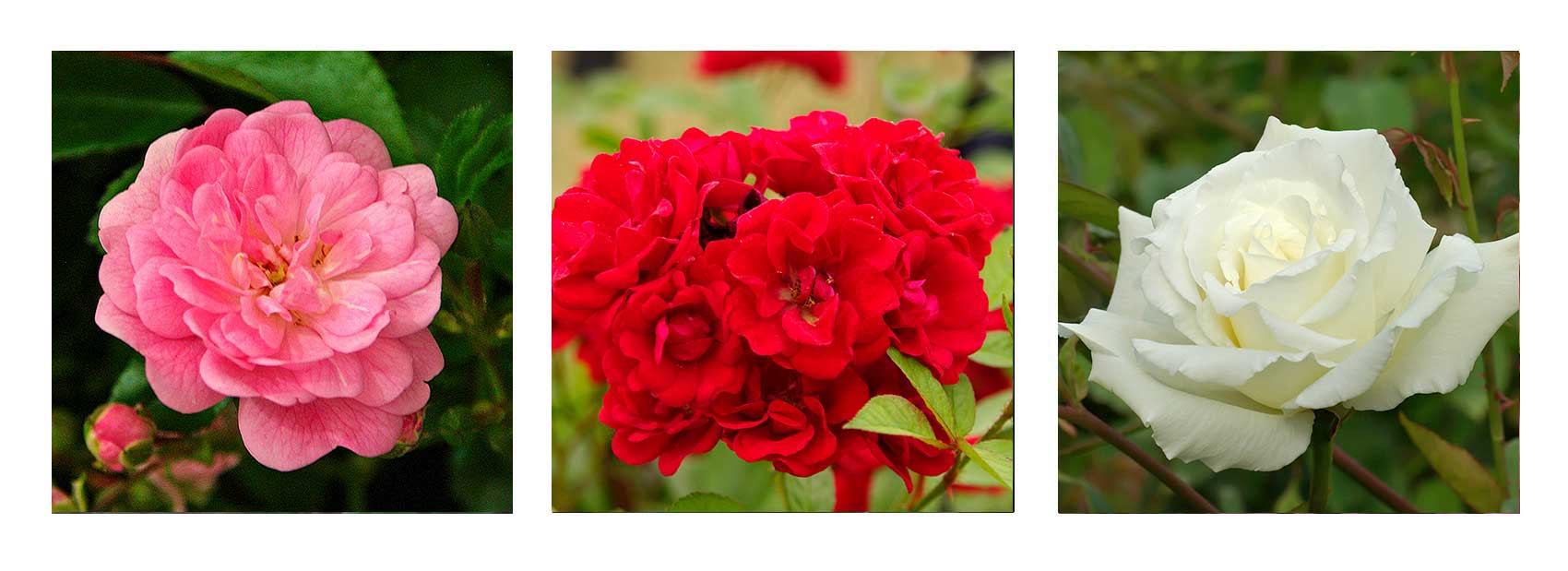 Polyantha Roses - (L) ‘The Fairy’ (C) ‘Miss Edith Cavell’ (R) 'Herbert Stevens'
Polyantha Roses - (L) ‘The Fairy’ (C) ‘Miss Edith Cavell’ (R) 'Herbert Stevens'It was the prolific blooming from spring to autumn that instantly sealed their popularity, with some plants producing so many flowers at once that they would totally cover the foliage. This attribute therefore made them attractive to landscapers wanting to make maximum impact.
Due to their compact nature they make a great edges to pathways or at the front of borders, while also being well suited to containers to bring colour to patios.
Polyantha roses tend to be low-maintenance and quite disease-resistant, remaining popular garden roses today over a century later. Popular cultivars include:- ‘Ballerina’, 'The Fairy', 'Pink Fairy', 'Red Fairy’, La Marne’, Verdun’ and ‘Miss Edith Cavell’.
Miniature Roses: These are scaled down versions of larger Modern Garden Roses, with heights ranging from 15cms to 60cms tall. Their flowers (5cms) and leaves are also appropriately smaller.
Modern miniature roses mainly derive from small China roses, especially the cultivar 'Rouletii', a chance discovery found in Switzerland.
Miniature roses are repeat-flowering shrubs producing small but bountiful blooms in a wide variety of colours and bloom formats.
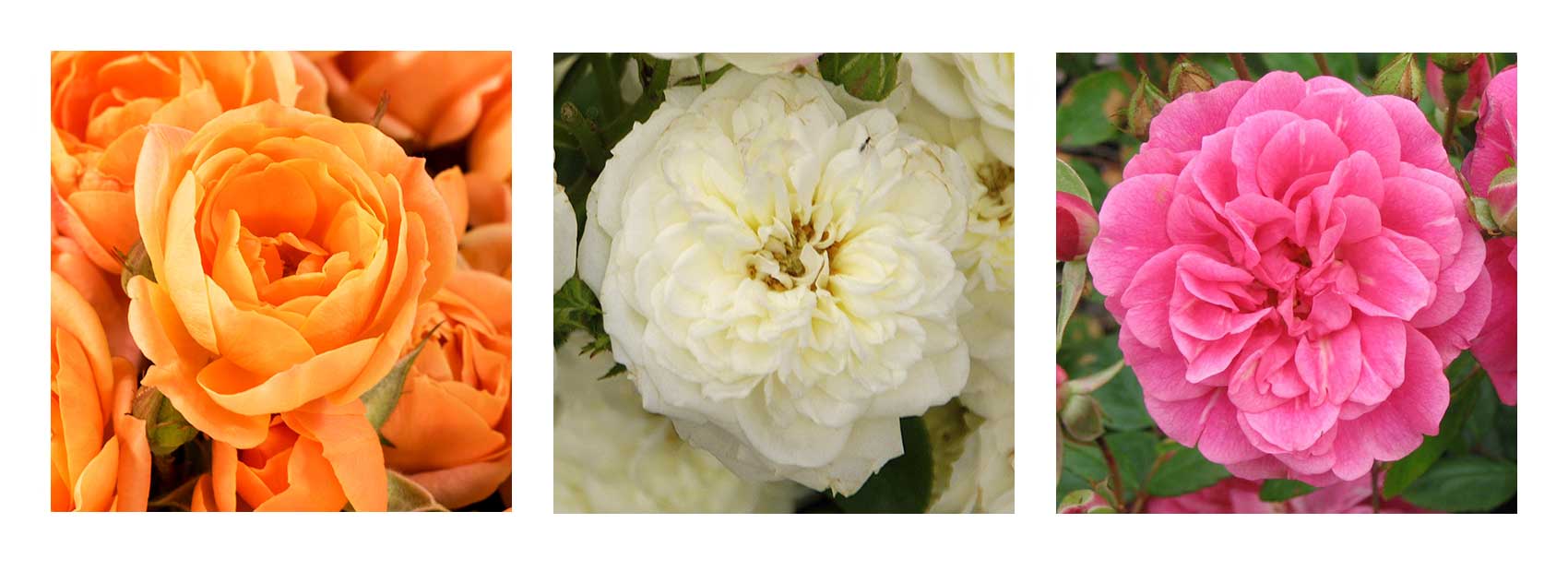 Miniature Roses - (L) ‘Apricot Clementine’ (C) ‘Snowcap’ (R) ‘China Doll’
Miniature Roses - (L) ‘Apricot Clementine’ (C) ‘Snowcap’ (R) ‘China Doll’They go well as path edging or even low hedges while due to their dimensions are perfect for pots, tubs and planters therefore providing the apartment dweller with an opportunity to grow these superb plants. Examples include: - ‘Snowcap’ by Harkness, ‘Little Sunset’, ‘Firecracker’, ‘Baby Jack’ and ‘Coco’.
Miniflora Roses: Miniflora roses are an ‘in-betweener’ being larger than Miniatures but smaller than Hybrid Teas and Floribundas. They offer all the advantages of their larger cousins e.g. high rising centre blooms (Hybrid Teas) continuous blooming (Floribundas) but its their ability to produce flowers quickly (around 30 days) as compared to the larger roses that need around 60 days that makes them really useful.
 Miniflora Roses - (L) ‘Vista’ (C) ‘Radiant’ (R) ‘Tidewater’
Miniflora Roses - (L) ‘Vista’ (C) ‘Radiant’ (R) ‘Tidewater’Minifloras are generally shapely, with attractive glossy foliage and quite hardy and being mid sized they go well in just about any situation from balcony pots to colourful borders. They also make excellent cut flowers. Examples include: ‘Ambiance’, ‘Equinox’, ‘Flawless’, ‘Robin Alonso’ and ‘Shenandoah’.
Patio Roses: A more recent (circa 1996) term to describe a rose that is larger than miniatures but still compact, free-flowering and suitable for a container on a patio or terrace, hence the name. Many are sold as standard rose forms of roses from other groups e.g. ‘Iceberg’, ‘Bonica’, ‘Brindabella’ and ‘Valencia’.
 Patio Roses - (L) ‘Hand-in-Hand’ (C) ‘Wonderful News’ (R) ‘Honeybun’
Patio Roses - (L) ‘Hand-in-Hand’ (C) ‘Wonderful News’ (R) ‘Honeybun’The terms Miniflora and Patio rose are often confused.
Well known examples include ‘’Hand-in-Hand’, ‘Flower Power’, ‘Honeybun’ and Wonderful News’
Shrub Roses:
Now this is where things get messy with everyone clamouring to get their prized cultivars or groups recognised by the world. As a result the naming of groups or types can vary wildly – we will attempt to apply some order to the chaos.
English Roses: Encompass the work of many skilled breeders like Harkness, Peter Beales, Cants, Fryers and Pauls of Cheshunt amongst others. But if you search on Google for ‘English roses’ the results are dominated by one breeder.
So let's start with the most famous, an English rosarian who has single handedly changed the face of the industry.
David Austin: Keen on roses since his childhood, David Austin produced his first commercially available rose in 1961. ‘Constance Spry’ was an immediate hit and he went on to produce over 200 more from his large family business in Albrighton, Shropshire. They vary in shape and form but all tend to capture that romantic, old-garden spirit so well captured by Chintz fabrics.
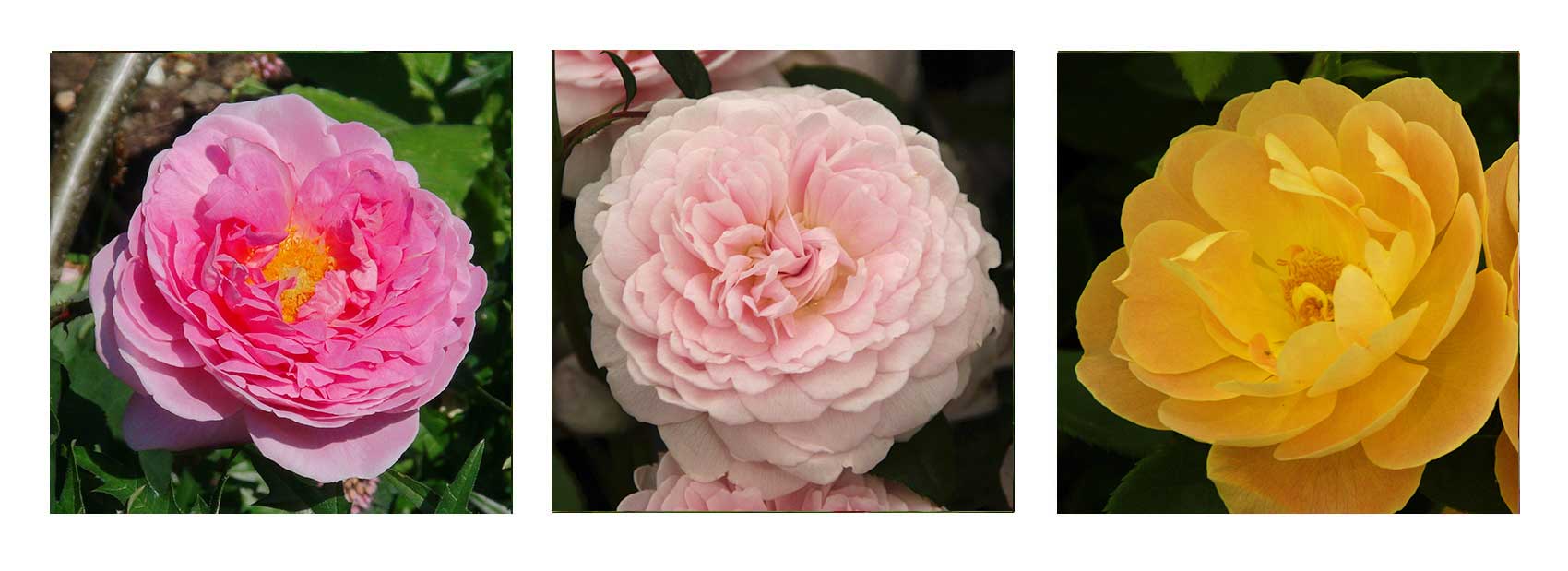 David Austin Roses - (L ‘Constance Spry’ (C) ‘Queen of Sweden’ (R) ‘Lark Ascending’
David Austin Roses - (L ‘Constance Spry’ (C) ‘Queen of Sweden’ (R) ‘Lark Ascending’He aimed to capture the essence of the Gallicas, Damasks and Albas while adding the resilience and repeat flowering of modern roses. Austin was also quite astute in leveraging English icons into the naming of his cultivars drawing on literature (Shakespeare, Chaucer and Hardy), landmarks, historical celebrities (Sir Walter Raleigh and Benjamin Britten) and other famed rosarians like Graham Thomas.
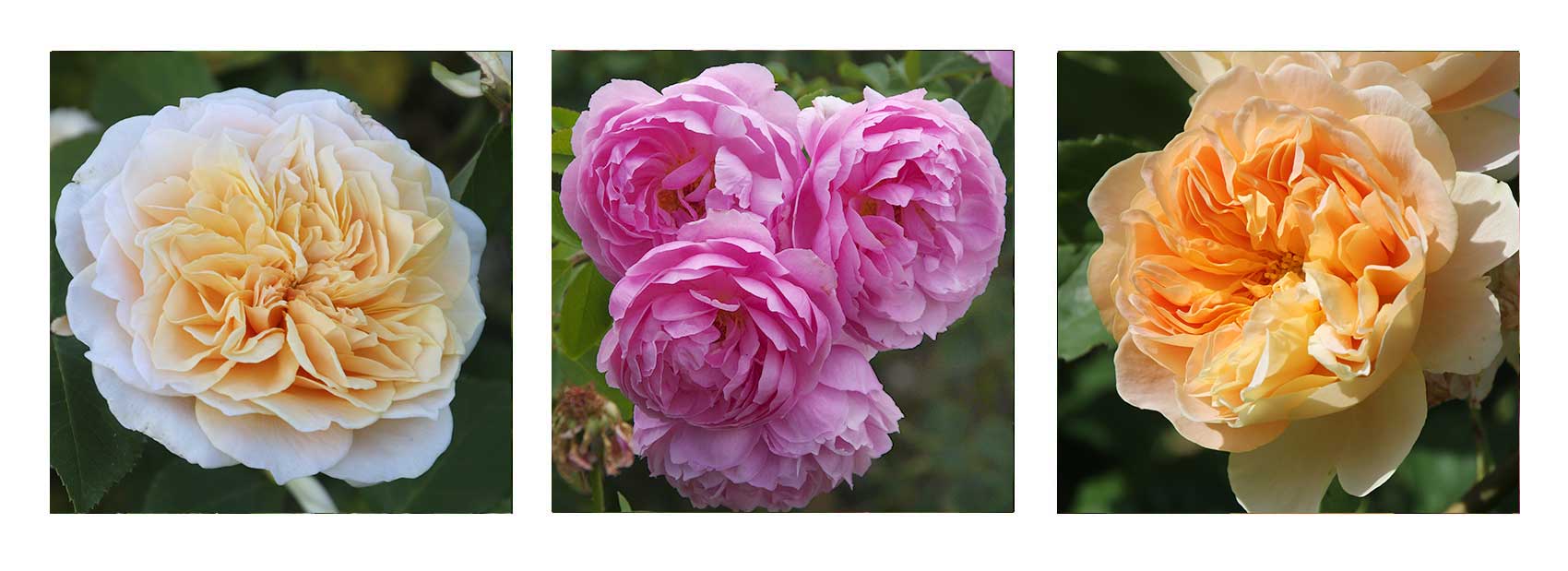 David Austin Roses - (L) ‘English Garden’ (C) ‘The Reeve’ (R) 'Tea Clipper
David Austin Roses - (L) ‘English Garden’ (C) ‘The Reeve’ (R) 'Tea ClipperThe end result was a new range of fragrant roses that embraced English culture while reflecting the English aesthetic – if ever there is a case history to demonstrate horticultural marketing savvy, then David H.C. Austin has to be the man.
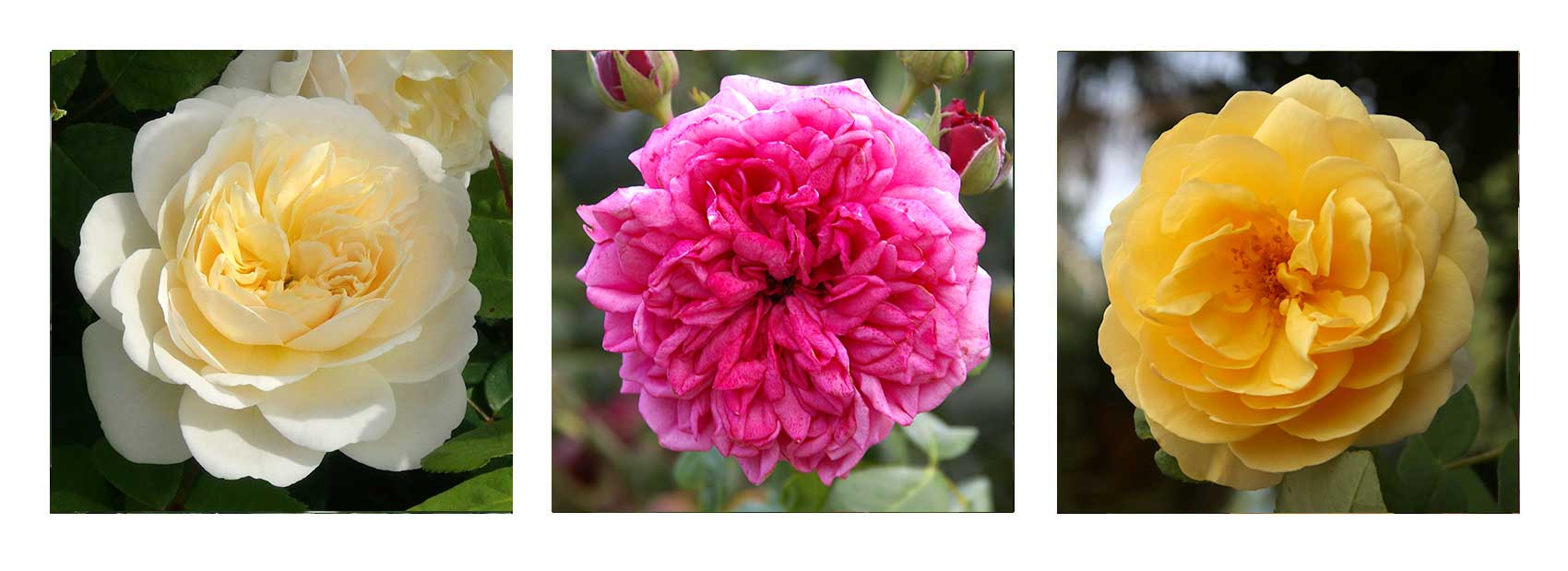 David Austin Roses - (L) ‘Crocus’ (C) ‘Mary Rose’ (R) ‘Graham Thomas’
David Austin Roses - (L) ‘Crocus’ (C) ‘Mary Rose’ (R) ‘Graham Thomas’A garden of these outstanding roses is hard to beat for the sheer exuberance of flower and fragrance.
Some fabulous examples include: ‘Golden Celebration, ‘The Reeve’, ‘Graham Thomas’, ‘Mary Rose’, L.D. Braithwaite’, ‘Ambridge Rose’, ‘The Pilgrim’, ‘Jude the Obscure’, ‘Scepter’d Isle’, ‘Lady of Shallot’ and ‘Gertrude Jekyll’ amongst many others.
Hybrid Musk Roses: are a relatively rare group that were developed from the old Musk Rose 'Rosa moschata' mainly in England in the early 20th century by a clergyman Joseph Pemberton. (Hence the reason they are sometimes called Pemberton Roses).
These roses appear delicate but are in fact very hardy, combining gorgeous fragrance with extremely good vigour and beautiful, soft coloured flowers.
They go well planted as gracefully spreading shrubs or low climbers and are very well suited to scrambling over walls and fences.
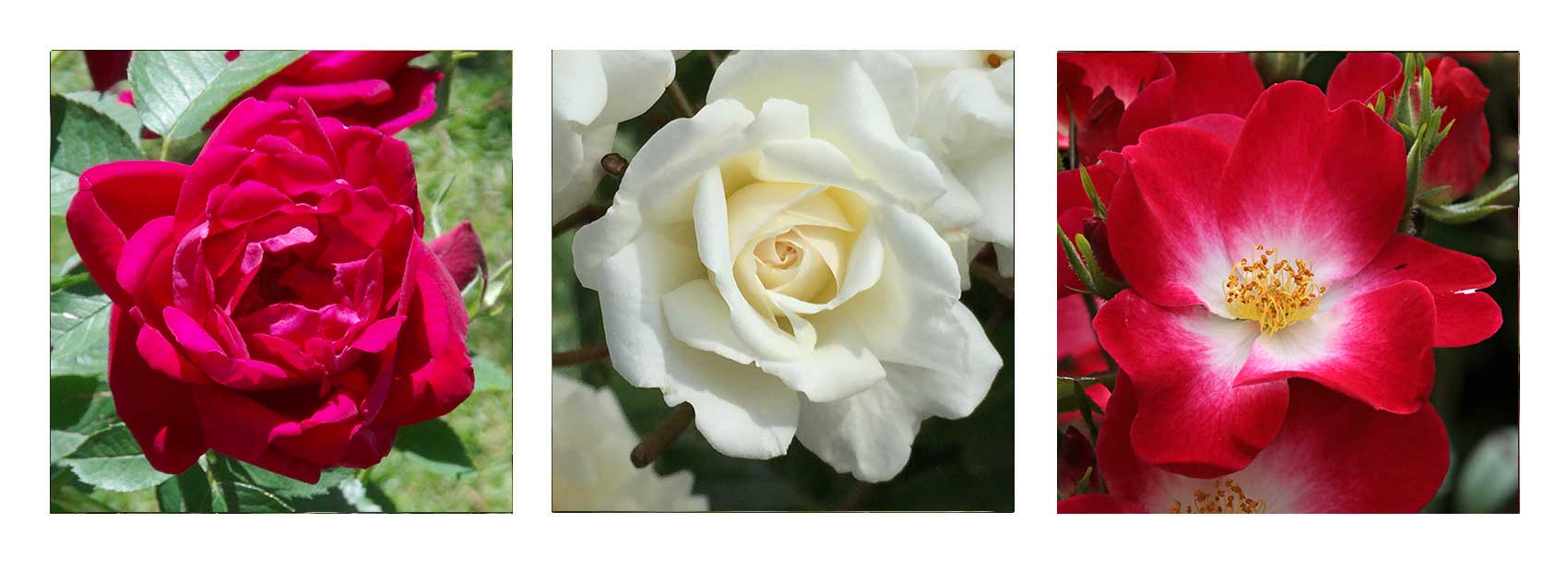 Hybrid Musk Roses - (L) ‘Will Scarlet’ (C) ‘Prosperity’ (R) ‘Bukavu’
Hybrid Musk Roses - (L) ‘Will Scarlet’ (C) ‘Prosperity’ (R) ‘Bukavu’They like plenty of sun but can handle partial shade, they are particularly floriferous and are renowned for their repeat blooming - though individual blooms can be relatively small.
Hybrids Musk Roses are usually found in shades of red, pink, white, yellow and apricot.
These are tough roses, being able to withstand greater ranges of temperature than many others.
Hybrid Musk roses are sometimes confused with Polyantha roses - ‘Ballerina’ and ‘Bukavu’ being a case in point.
Modern Shrub Roses: as mentioned above this is a very diverse group with many rose breeders clamouring for their own recognition. However all Modern Shrub Roses enjoy distinct and useful attributes which is why they are set apart with their own group.
Most notably they are not grafted but grown on their own rootstock which means they tend to be much lower maintenance plants as they can be left un-pruned yet they will still flower year on year. Modern Shrub Roses are particularly suited to large municipal plantings where pruning may be done mechanically with mechanised cutters - most other rose types wouldn't enjoy this at all.
They are long lasting and very floriferous, producing large amounts of pollen which in turn attract more birds, bees and insects to your garden. (though due to the lack of nectar they do not attract Butterflies).
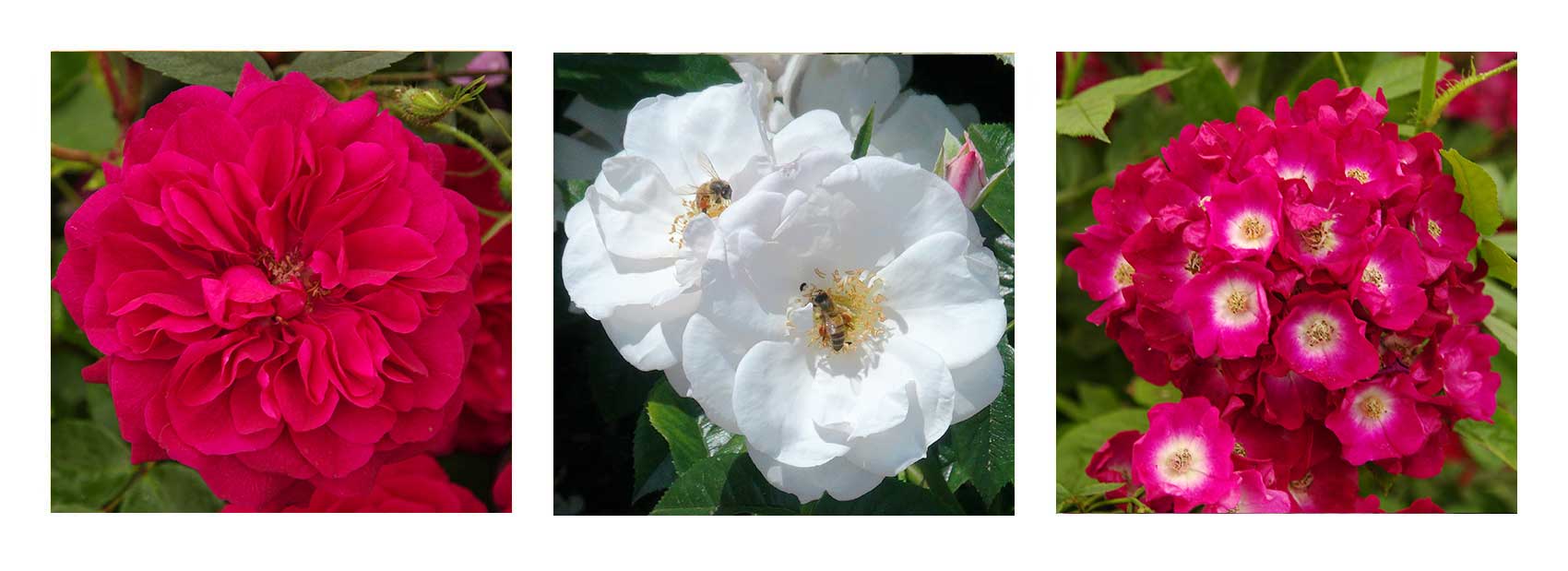 Modern Shrub Roses - (L) ‘Frilly Cuff’ (C) ‘Pearl Drift’ (R) ‘Marjorie Fair’
Modern Shrub Roses - (L) ‘Frilly Cuff’ (C) ‘Pearl Drift’ (R) ‘Marjorie Fair’These roses are perfect for larger scale plantings, where you want swathes of colour and minimal maintenance - sounds like a gardener's dream !!
Other Groups include:
Delbard: A recent collection of highly perfumed shrubs and climbers from Delbard of Alliers, France.
Generosa: Modern roses introduced by french company, Roseraie Guillot. Just like David Austin’s English roses, Générosa roses exhibit old garden rose sensibilities with modern, repeat bloom.
Meilland: From the breeders of the world famous ‘Peace Rose’ come a range of roses that encompass French-ness (As Austin is to English roses). This famed breeder operates the world over offering their version of the Romance of French Gardens via a large and beguiling collection of beautiful and fragrant blooms.
Examples include :- ‘Paul Ricard’, ‘Jeanne Moreau’, ‘Yves Piaget’, ‘Toulouse Lautrec’ and ‘Charles de Gaulle’ amongst many others.
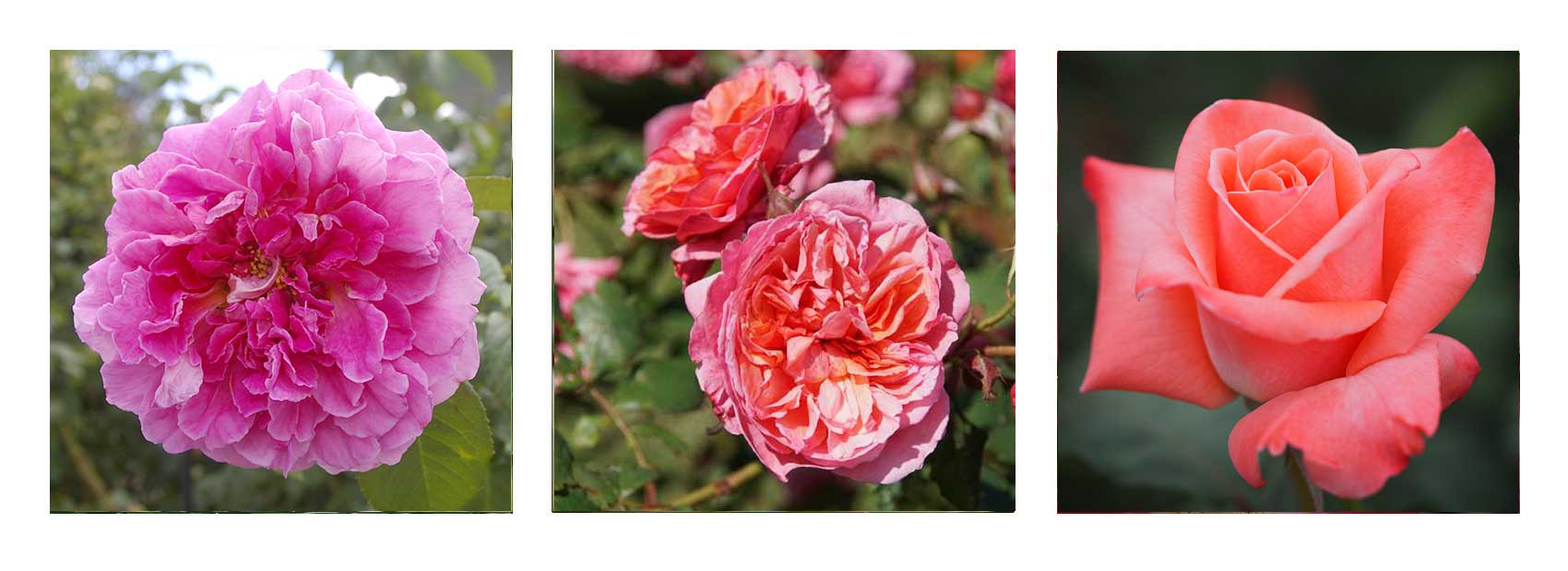 Other Modern Rose groups - (L) Delbard (C) Generosa (R) Meilland
Other Modern Rose groups - (L) Delbard (C) Generosa (R) MeillandMeidiland: These roses come from the famous French breeder, Meilland, and are defined as low-maintenance, rugged, repeat-blooming, etc. In short, a perfect landscape rose. Often Meidiland roses are ground-hugging and make for good erosion control. This range of roses was created largely for landscapers to make quick and colourful impact in larger spaces like parks and public gardens.
Harkness: Marketed in France and Germany as English Legend® these are a group of hardy shrub roses much in the vein of David Austin and Romantica roses created by the English company, Harkness, which has been in business since 1879.
Examples include: ‘Tower Bridge’, Ginger Syllabub’, ‘Jaqueline de Pre’, Judy Garland’ and ‘Remembrance’.
Kordes: A German company that is over 120 years old specialising in rose hybridisation. They currently sell over 2 million roses internationally.
Examples include:- ‘Alchymist’, ‘Burghausen’, ‘Dortmund’, ‘Eureka’, ‘Fritz Nobis’ and ‘Leverkusen’ amongst many others. ‘Iceberg’ is a famous example of a Kordes rose. The New Generation® roses of Kordes offer low maintenance and disease resistance.
Renaissance Roses: Poulsen of Denmark’s version of the “English Rose.” An Old Garden rose appearance with strongly scented blossoms and repeat blooms.
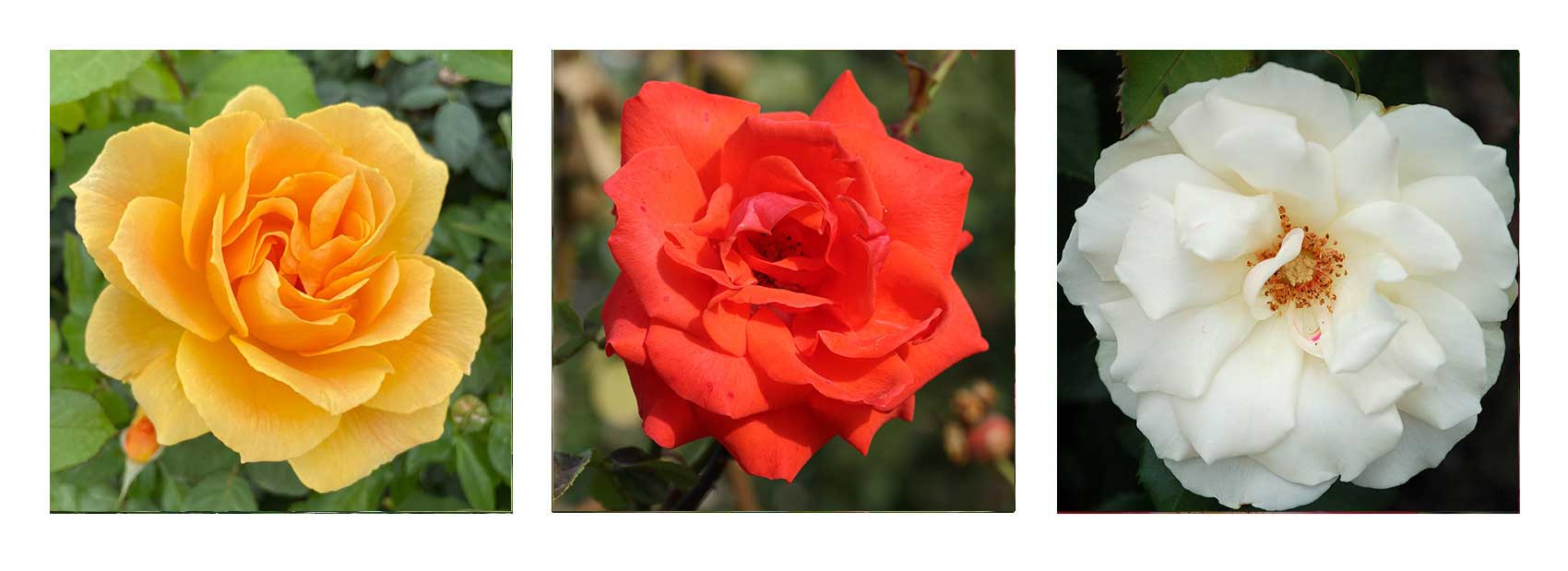 Other Modern Rose groups - (L) Harkness (C) Kordes (R) Poulsen
Other Modern Rose groups - (L) Harkness (C) Kordes (R) PoulsenInternationally Famous rose breeders include:
- Peter Beales of Norfolk UK
- Cant of Colchester UK
- Dicksons of Belfast Northern Ireland
- McGredy of Northern Ireland
- Pauls of Hertfordshire UK
- Fryers Roses of Knutsford, Cheshire UK
- James Crocker of Scotland
- Rose Barni from Tuscany, France
- Pernet-Ducher of Lyon, France
- Rene-Barbier of Orleans, France
- Werner Noack of Germany
- Tantau of Germany
- Pedro Dot of Spain,
- Conard-Pyle of West Pennsylvania, USA
- Jackson & Perkins of USA
- Ralph Moore of California, USA
- Weeks Roses of California, USA
- William Radler of USA
- De Ruiter Roses of Netherlands
- Interplant Roses of Netherlands
- Schreurs of Netherlands
- Pheno Geno Roses - Netherlands and Serbia
- Swanes of Dural, Australia
- Ross Roses of South Australia
- Nieuwesteeg of Victoria, Australia
- Grandiflora Roses - Australia